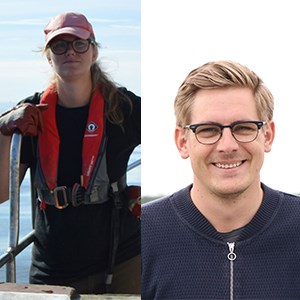Isa and Erik are both researchers at the beginning of their careers at the Department of Aquatic Resources (SLU Aqua). Last autumn, Isa defended her doctoral thesis, which focused on the invasive round goby's way of life and interaction with native fish species. Erik is a PhD student and is currently working on his project "ePIKE" where he investigates the possibilities of using eDNA as a non-invasive method of Swedish pike populations.
Otolith chemistry of eastern Baltic cod
Isa's new project is about otolith chemistry in cod and can contribute to new knowledge about factors that affect the growth of cod from the Bornholm Basin. This, in turn, is expected to have an impact on cod management and may ultimately contribute to improving the ecological status of the Baltic Sea.
First of all, how does it feel to have received this scholarship Isa?
– I’m very happy, it's a great encouragement! It's also exciting to learn a method that I haven't worked with before, and it's also fun to focus on a species that I haven't worked with that much before.
You will perform chemical analyses on otoliths from 60 cod – tell us more about that, how did you get the idea and what do you want to achieve?
– The idea arose in conversations with colleagues at the Institute of Coastal Research and through contacts at DTU Aqua in Denmark. The otoliths have already been collected, and in this first step of the project I will prepare them and send them off for analysis. Then I need to apply for more funding to have time to analyze the data and write it up. One goal is to try to see if changes in metabolism in the cod, due to liver parasites, are reflected in the chemical composition of the otoliths. I will also investigate whether this effect can be distinguished from the effects of hypoxia that the cod have experienced.
How do you perform chemical analyses on otoliths?
– The otoliths are first prepared by mounting them in epoxy. A cross-section is then sawn so that the core of the otolith is revealed, then the otoliths are grinded and polished and then sent away for analysis using laser technology.
Anything else you'd like to tell us about?
– The project is a collaboration between the Swedish University of Agricultural Sciences (SLU), DTU Aqua (Denmark) and SUNY-ESF (USA), which is very exciting, Isa concludes.
Application of eDNA for quantitative monitoring of pike
Erik's project "ePIKE" is about the application of eDNA for quantitative monitoring of pike. The aim of the project is to investigate whether metabarcoding (a method where barcoding of DNA is read) can be used to analyze all fish species in a single sample. With the help of increased knowledge about our fish stocks, developed with non-invasive methods, Erik hopes to contribute to informed decisions in the management of the stocks.
Erik, how does it feel to have received this scholarship?
– It's a great honour! It's also fun to have the chance to continue exploring the possibilities of eDNA as a quantitative monitoring method and to be able to test this method.
Can you tell us more about your project, how you got the idea and what you want to achieve?
– The project is a continuation of my PhD project 'ePIKE'. In that particular project we have seen that the amount of eDNA correlates with the amount of pike that are present in an area. In the project, we have used a so-called single-species analysis with qPCR (quantitative polymerase chain reaction) and where we have only looked at the amount of DNA from pike. But many of the samples that we have taken also have information about the amount of other species in the area. Therefore we want to see if we can re-analyze these samples with the help of multi-species analysis through metabarcoding. In this way, we can see if the amount of DNA from all species relates to the amount of species found in the area. We also plan to investigate how the measurements of eDNA from these two methods (qPCR and metabarcoding) relate to each other when it comes to pike.
Can you introduce us to the DNA metabarcoding method?
– In single-species analysis, you quantify a short sequence of DNA that is specific and unique to the species you are looking to investigate. In multi-species analysis with metabarcoding, a sequence of DNA is identified that is specific to a certain group of organisms, such as bony fishes, but has a large variation within the DNA sequence depending on the species. By first separating these DNA sequences from a water sample, and then analyse and attributing them to each species, you get a measure of how many copies of each sequence belonging to each species are present in the sample, Erik concludes.
Text: Josefine Karlsson
Photo: Isa Wallin Kihlberg, photo: Anders Nissling. Erik Karlsson, photo: Teresa Soler.
To Vårt SLU
